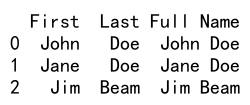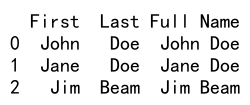Pandas Concat Two Columns
Pandas is a powerful Python library used for data manipulation and analysis. One of the common tasks when working with data is combining or concatenating columns. This article will explore various methods to concatenate two columns in a DataFrame using the Pandas library. We will provide detailed examples with complete, standalone code snippets that can be executed independently.
Introduction to DataFrame
A DataFrame is a two-dimensional, size-mutable, potentially heterogeneous tabular data structure with labeled axes (rows and columns). Before diving into concatenating columns, let’s first understand how to create a DataFrame.
Example 1: Creating a DataFrame
import pandas as pd
data = {
'Column1': ['pandasdataframe.com', 'example1', 'example2'],
'Column2': ['example3', 'pandasdataframe.com', 'example5']
}
df = pd.DataFrame(data)
print(df)
Output:

Basic Concatenation of Two Columns
Concatenating two columns typically involves combining the data from these columns into a single column. This can be done in several ways depending on the data type and the desired output format.
Example 2: Concatenating Two String Columns
import pandas as pd
data = {
'Name': ['Alice', 'Bob', 'Charlie'],
'Domain': ['pandasdataframe.com', 'example.com', 'test.com']
}
df = pd.DataFrame(data)
df['Email'] = df['Name'] + '@' + df['Domain']
print(df)
Output:

Example 3: Using apply() with a lambda function
import pandas as pd
data = {
'First': ['John', 'Jane', 'Jim'],
'Last': ['Doe', 'Doe', 'Beam']
}
df = pd.DataFrame(data)
df['Full Name'] = df.apply(lambda row: row['First'] + ' ' + row['Last'], axis=1)
print(df)
Output:

Concatenating with Separators
Often, you might want to concatenate two columns with a separator that is not just the empty string. This can be done using the + operator or more flexibly with the str.cat() method.
Example 4: Concatenating with a Custom Separator
import pandas as pd
data = {
'ID': [1, 2, 3],
'Code': ['A', 'B', 'C']
}
df = pd.DataFrame(data)
df['ID_Code'] = df['ID'].astype(str) + '-' + df['Code']
print(df)
Output:

Example 5: Using str.cat()
import pandas as pd
data = {
'First': ['John', 'Jane', 'Jim'],
'Last': ['Doe', 'Doe', 'Beam']
}
df = pd.DataFrame(data)
df['Full Name'] = df['First'].str.cat(df['Last'], sep=' ')
print(df)
Output:

Handling Missing Data During Concatenation
Concatenating columns where some entries might be missing (NaN values) requires careful handling to avoid introducing incorrect data.
Example 6: Concatenation with Missing Values
import pandas as pd
import numpy as np
data = {
'First': ['John', 'Jane', None],
'Last': ['Doe', 'Doe', 'Beam']
}
df = pd.DataFrame(data)
df['Full Name'] = df['First'].fillna('') + ' ' + df['Last'].fillna('')
print(df)
Output:

Advanced Concatenation Techniques
Beyond simple concatenation, Pandas offers powerful tools for more complex merging and joining scenarios.
Example 7: Concatenating Multiple Columns
import pandas as pd
data = {
'First': ['John', 'Jane', 'Jim'],
'Middle': ['T', None, 'G'],
'Last': ['Doe', 'Doe', 'Beam']
}
df = pd.DataFrame(data)
df['Full Name'] = df[['First', 'Middle', 'Last']].apply(lambda x: ' '.join(x.dropna()), axis=1)
print(df)
Output:

Example 8: Using concat() Function
import pandas as pd
df1 = pd.DataFrame({'A': ['pandasdataframe.com', 'foo', 'bar']})
df2 = pd.DataFrame({'B': ['baz', 'pandasdataframe.com', 'qux']})
result = pd.concat([df1, df2], axis=1)
print(result)
Output:

Pandas Concat Two Columns Conclusion
Concatenating columns in Pandas is a versatile operation that can be tailored to fit specific needs, whether you are dealing with simple string concatenation or more complex scenarios involving multiple columns and handling missing data. The examples provided in this article demonstrate various methods and should serve as a foundation for more advanced data manipulation tasks.
This article has covered a range of techniques from basic concatenation to more advanced methods, ensuring a comprehensive understanding of how to effectively concatenate two columns in Pandas.
 Pandas Dataframe
Pandas Dataframe